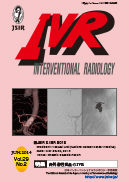29 巻, 2 号
選択された号の論文の15件中1~15を表示しています
- |<
- <
- 1
- >
- >|
特集
非外傷性出血のIVR
-
2014 年 29 巻 2 号 p. 121-126
発行日: 2014年
公開日: 2015/04/22
PDF形式でダウンロード (918K) -
2014 年 29 巻 2 号 p. 127-133
発行日: 2014年
公開日: 2015/04/22
PDF形式でダウンロード (967K) -
2014 年 29 巻 2 号 p. 134-139
発行日: 2014年
公開日: 2015/04/22
PDF形式でダウンロード (1026K) -
2014 年 29 巻 2 号 p. 140-146
発行日: 2014年
公開日: 2015/04/22
PDF形式でダウンロード (1137K) -
2014 年 29 巻 2 号 p. 147-152
発行日: 2014年
公開日: 2015/04/22
PDF形式でダウンロード (1087K)
症例報告
-
2014 年 29 巻 2 号 p. 153-156
発行日: 2014年
公開日: 2015/04/22
PDF形式でダウンロード (888K) -
2014 年 29 巻 2 号 p. 157-161
発行日: 2014年
公開日: 2015/04/22
PDF形式でダウンロード (932K)
第42回日本IVR学会総会「技術教育セミナー」より
静脈血栓塞栓症のIVR
-
2014 年 29 巻 2 号 p. 162-165
発行日: 2014年
公開日: 2015/04/22
PDF形式でダウンロード (837K) -
2014 年 29 巻 2 号 p. 166-172
発行日: 2014年
公開日: 2015/04/22
PDF形式でダウンロード (1292K) -
2014 年 29 巻 2 号 p. 173-180
発行日: 2014年
公開日: 2015/04/22
PDF形式でダウンロード (1576K) -
2014 年 29 巻 2 号 p. 181-185
発行日: 2014年
公開日: 2015/04/22
PDF形式でダウンロード (769K)
外傷IVRの基本と応用
-
2014 年 29 巻 2 号 p. 186-187
発行日: 2014年
公開日: 2015/04/22
PDF形式でダウンロード (574K) -
2014 年 29 巻 2 号 p. 188-194
発行日: 2014年
公開日: 2015/04/22
PDF形式でダウンロード (1418K) -
2014 年 29 巻 2 号 p. 195-202
発行日: 2014年
公開日: 2015/04/22
PDF形式でダウンロード (1601K) -
2014 年 29 巻 2 号 p. 203-209
発行日: 2014年
公開日: 2015/04/22
PDF形式でダウンロード (1454K)
- |<
- <
- 1
- >
- >|
